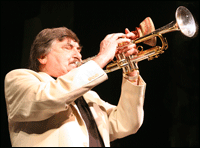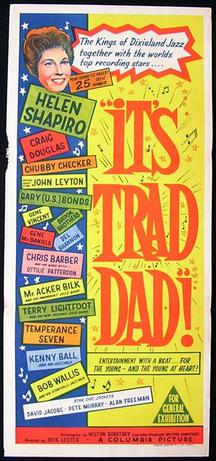Swing music is a style of jazz that developed in the United States during the late 1920s and early '30s. It became nationally popular from the mid-1930s. The name derived from its emphasis on the off-beat, or nominally weaker beat. Swing bands usually featured soloists who would improvise on the melody over the arrangement. The danceable swing style of big bands and bandleaders such as Benny Goodman was the dominant form of American popular music from 1935 to 1946, known as the swing era, when people were dancing the Lindy Hop. The verb "to swing" is also used as a term of praise for playing that has a strong groove or drive. Musicians of the swing era include Duke Ellington, Benny Goodman, Count Basie, Cab Calloway, Jimmy Dorsey, Tommy Dorsey, Woody Herman, Harry James, Lionel Hampton, Glenn Miller, Artie Shaw, Jimmie Lunceford, and Django Reinhardt.

Bernard Stanley "Acker" Bilk, was an English clarinetist and vocalist known for his breathy, vibrato-rich, lower-register style, and distinctive appearance – of goatee, bowler hat and striped waistcoat.

George Lewis was an American jazz clarinetist who achieved his highest profile in the later decades of his life.

Music in the United States underwent many shifts and developments from 1900 to 1940. The country survived both World War I and the Great Depression before entering World War II in December 1941. Americans endured great loss and hardship but found hope and encouragement in music. The genres and styles present during this period were Native American music, blues and gospel, jazz, swing, Cajun and Creole music, and country. The United States also took inspiration from other cultures and parts of the world for her own music. The music of each region differed as much as the people did. The time also produced many notable singers and musicians, including jazz figure Louis Armstrong, blues and jazz singer Mamie Smith, and country singer Jimmie Rodgers.

Kenneth Daniel Ball was an English jazz musician, best known as the bandleader, lead trumpet player and vocalist in Kenny Ball and his Jazzmen.

Donald Christopher Barber was an English jazz musician, best known as a bandleader and trombonist. He helped many musicians with their careers and had a UK top twenty trad jazz hit with "Petite Fleur" in 1959. These musicians included the blues singer Ottilie Patterson, who was at one time his wife, and Lonnie Donegan, whose appearances with Barber triggered the skiffle craze of the mid-1950s and who had his first transatlantic hit, "Rock Island Line", while with Barber's band. He provided an audience for Donegan and, later, Alexis Korner, and sponsored African-American blues musicians to visit Britain, making Barber a significant figure in launching the British rhythm and blues and "beat boom" of the 1960s.

Kenneth Colyer was an English jazz trumpeter and cornetist, devoted to New Orleans jazz. His band was also known for skiffle interludes.

Monty Sunshine was an English jazz clarinettist, who is known for his clarinet solo on the track "Petite Fleur", a million seller for the Chris Barber Jazz Band in 1959. During his career, Sunshine worked with the Eager Beavers, the Crane River Jazz Band, Beryl Bryden, George Melly, Chris Barber, Johnny Parker, Diz Disley and Donegan's Dancing Sunshine Band.

It's Trad, Dad! is a 1962 British musical comedy film directed by Richard Lester in his feature directorial debut. It stars singer and actress Helen Shapiro alongside Craig Douglas, John Leyton, the Brook Brothers, and Chubby Checker, among other rock-and-roll singers, as well as several Dixieland jazz bands. The film was one of the first produced by Amicus Productions, a company known predominantly for horror films.
Robert Wallis was a British jazz musician, who had a handful of chart success in the early 1960s, during the UK traditional jazz boom.
Alex Welsh was a Scottish jazz musician who played cornet and trumpet and was also a bandleader and singer,

Albert Nicholas was an American jazz clarinet player.
Terence Lightfoot was a British jazz clarinettist and bandleader, and together with Chris Barber, Acker Bilk and Kenny Ball was one of the leading members of the trad jazz generation of British jazzmen.
Malcom Bruce Turner was an English jazz saxophonist, clarinetist, and bandleader.
Peter Sidney "Mick" Mulligan was an English jazz trumpeter and bandleader, best known for his presence on the trad jazz scene.
Stomp Off is an American jazz record company and label founded in 1980 by Bob Erdos in York, Pennsylvania. The label's first release was Feelin' Devilish by Waldo's Gutbucket Serenaders.
Dixieland jazz, also referred to as traditional jazz, hot jazz, or simply Dixieland, is a style of jazz based on the music that developed in New Orleans at the start of the 20th century. The 1917 recordings by the Original Dixieland Jass Band, fostered awareness of this new style of music.
Keith John Smith was a British jazz trumpeter, principally active on the trad jazz and Dixieland revival scenes.
Rod Mason was an English musician who played trad jazz.
Ian Hunter-Randall was an English trad jazz trumpeter born in London.










